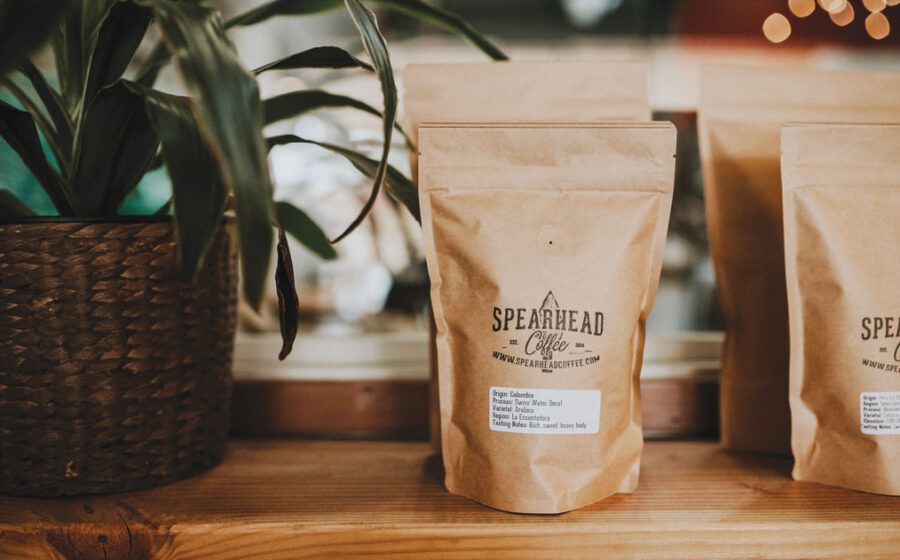[I]t took Spearhead Coffee nine months to build out their café in Paso Robles, California. It’s an artsy town well-versed in craft, so each design detail was thoughtfully planned. Industrial light fixtures and intricate paneling made of reclaimed redwood give it a local grounding, and a stainless steel bar that sits lower to the ground is wheelchair accessible while eliminating any boundaries between guests and barista.
The space opened in late 2014 and quickly became popular in the community filled with artists, winemakers, musicians, brewers, and chefs. “We want people to feel welcome, want them to have the most amazing cup of coffee they’ve ever had, and be truly inspired by the decor and by the vibe of the café,” says Jeremy Sizemore, one of Spearhead’s co-owners. He emphasizes that it’s also about encouraging people to investigate what the café is all about—to not only be inspired by what they’re doing, but the why behind each decision.
Old-growth redwood (saved from a landfill) dominates the space. Lattices of two-by-fours support streams of hanging bulbs over the espresso and pour-over bars, and more paneling fills out the bar’s front, with shelving nooks built in for lush plants and branded mugs. Windows line the shop’s front walls. Inside, a two-kilo Ambex is easily visible behind more glass, allowing customers a direct view to the normally behind-the-scenes operations. A two-group, La Marzocco Linea handles the espresso demands, and a Fetco batch brewer serves up the daily drip selection.
The café and roastery features coffees from Thailand, Haiti, and El Salvador—a callback to the globetrotting days of co-owners Sizemore, Matt Klomp, and Joseph Gerardis. Each has devoted time to coffee and humanitarian work in other countries, a passion that puts a unique spin on every aspect of the shop, making it a place for community, education, growth, and, perhaps most importantly, the development of art.
Sizemore spent his early coffee days importing, then managing a second-wave shop in San Luis Obispo. He soon started roasting for Gerardis at Joebella, a roastery in neighboring Atascadero, where the focus was organic specialty coffee from around the world. Not long after Sizemore stepped into the head roaster position for Joebella, talk of opening a specialty shop in Paso Robles began, and Klomp was recruited to leave his coffee work in Kona, Hawaii, to help launch the new operation. Talk turned into concrete plans, Klomp and his wife had moved to the Central Coast, and Spearhead started roasting after-hours at Joebella while construction began on the new café and roastery.
Sizemore says that coffee has changed a lot in Paso Robles since their arrival. He credits this smooth transition to the welcoming arms of the community, including the many brewmasters, chefs, and winemakers from the region who were eager to learn about a craft that heavily overlapped with their own. “There’s a lot of crossover between wine and coffee,” Sizemore says. “You can talk soil and elevation, tasting notes, acidity, sugars.”
Their commitment to making an impact globally and in the local community is readily apparent. Rows of benches in a side hallway are reserved as “laptop central,” while a cluster of high tables without electrical access are reserved for those coming to have conversation. A large community table sits at the heart of the space, where local community groups and nonprofits frequently gather.
“Our café is a hub for both businesses, but also nonprofits and a lot of community efforts,” Sizemore says. He describes the community table as a place where locals gather to hash out ideas to help the local and global communities.

Sizemore teaches guitar and band at the Paso Robles Youth Arts Foundation, and Spearhead has hired both staff and students from the foundation to work in the café. The café sources compostable cups from Reduce. Reuse. Grow., a program in Central California that grows a native plant for every cup used.
But a passion for positive change in the world doesn’t come at the expense of good coffee. Sizemore and his partners are just as tenacious about their pursuit of quality coffee—if not more. “We’re obsessive compulsive about sourcing the best coffee, roasting it the best possible way, and serving it the best possible way.”
Part of serving coffee in the best possible way means offering the same tools to their customers as they use on their slow bar. Retail shelves (made of old-growth redwood, of course) hold Hario V60s, timers, and scales, the same ones used for pour-overs at Spearhead. Customers can also pick up kettles, hand grinders, coffee, filters, and branded mugs.

Serving coffee in the best possible way also means being borderline obnoxious when it comes to sourcing. Sizemore describes his sourcing process as a near-endless series of questions seeking to ensure that a green coffee is not only good, but doing good things for the farmer and the surrounding community. “I want to know, is it helping the environment, too? Is it sustainable? We just agonize about those kinds of things,” he says. Spearhead works both with farmers directly and with brokers, using their network of global connections to verify the sources of their coffee when they can’t visit a farm directly.
As Spearhead builds a stronger foundation, Sizemore, Gerardis, and Klomp plan to visit each farm they source from to build direct-trade relationships. They’ve already connected their community to coffee farmers through a partnership with the local Rotary Club to support farmers in El Salvador. In the meantime, the community table at Spearhead will continue to host forward thinkers as they sip expertly roasted and brewed coffee, making plans to improve the community around them.
—Ellie Bradley is Fresh Cup‘s associate editor.

















